What is Fool's Arcana?
Fool's Arcana is a Tarot based card battle game for 2-4 players. You can add in more players if you like, but you'd better expand with another deck for every 2-4 players or you'll find yourself running out of cards pretty quickly. House rules, deviations, and adjustments are all encouraged. Make the game your own and feel free to let me know about your version.
Set up:
To play, you will need a tarot deck. It will be possible to play with a normal deck of cards but keep in mind that the page cards from the royalty will be missing. If playing with a standard deck, you’ll still need something to indicate the major arcana cards which players use as their avatars.
Before beginning, each player will need a card from the Major Arcana. House rules can dictate whether duplicates of the Major Arcana are allowed or not, or whether the Major Arcana are random or chosen by the players. Our standard is drawing a few at random and then letting players choose from those few.
General game rules:
One player shuffles the deck. Turns then progress in clockwise order starting with the player closest to the person who shuffled.
At the beginning of your turn, you draw two cards(up to five in your hand, which you can’t draw over without using an ability from a Major Arcana). For the first turn, nobody will have a draw phase because they will already be at their draw limit.
There are two main phases of the game to worry about: building and battle. You may build and battle in any order as long as you have cards to do so.
While building, you play cards to the table and may stack one card on top. You may place as many cards to the table from your hand as you are able. A card on top effectively “protects” the bottom card during a battle, as an opposing player must get through the top card in order to battle the bottom one. So in order to attack your card, they must first remove the card on top of it. You cannot stack on top of a stacked card, so choose your protectors wisely!
You are limited to four “bottom” slots and four “stacked” slots on top of those. You may only stack a card on top of another if the suits match, or the numeric value does. The game ends when a player has four full stacks of cards in play, or when the draw pile is emptied. At that point, the winner of the game is whichever player has the most numeric points down in their stacks. Keep in mind that you can end the game and still lose if you don’t have enough points stacked, so choose when to end the game with care.
Every turn, you may voluntarily “sacrifice” one of your cards from play to the discard pile in order to free up a space for another card. You cannot sacrifice a bottom card while a card is stacked on top, you must first get rid of the top card.
Here is an example of a two-player game in progress:
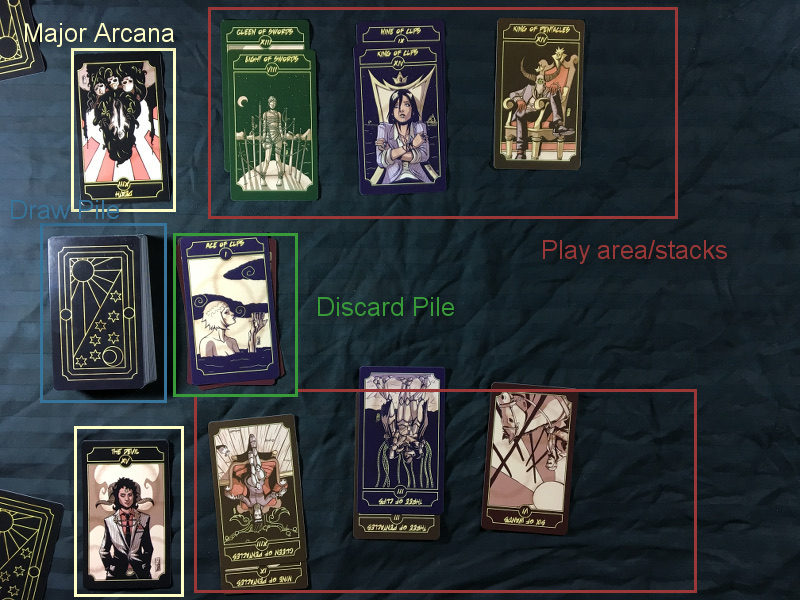
If you choose to battle another player, you select a target card and then play your card against it. A card attacking another card must match or exceed the numeric value of the card being attacked in order to win the fight. Both cards then go to the discard pile, however you can continue to protect your stacked cards by counterattacking.
The player being attacked can use the cards in their hand to counterattack the attacking card. Then the attacking player has the opportunity to counter the counterattack. This can continue until a player opts not to fight back, or until they are out of cards in their hand. In the case of a long attack chain, the last card played attacks first and then the chain resolves from the top card on down, one by one. Every card used in battle resolves to the discard pile, but if an attack is successfully countered, the original card being attacked stays in place.
You may also attack with stacked cards, but you may only stack one card on top of a bottom one. The same stacking rules for building applies to cards used in battle. For the sake of the battle, the stacked cards act as a single card with a point value that is the sum of the two stacked cards. Your opponent must match or beat that number to defeat the stacked cards.
Players cannot use low-point value cards to attack higher point value cards. The attacking card value(or cards, if stacked) must match or beat the point value of the card they are attacking.
Here is an example battle unfolding.
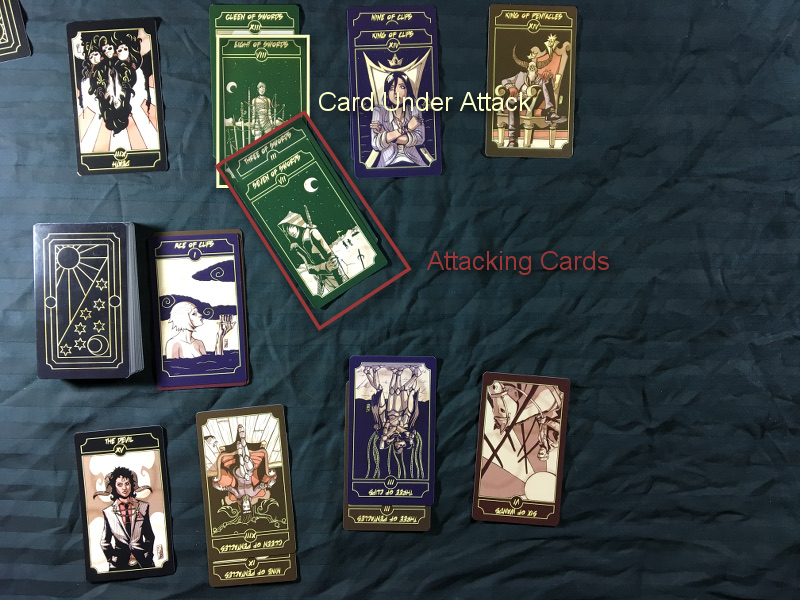
The Eight of Swords is being attacked by the combined Three and Seven of Swords.
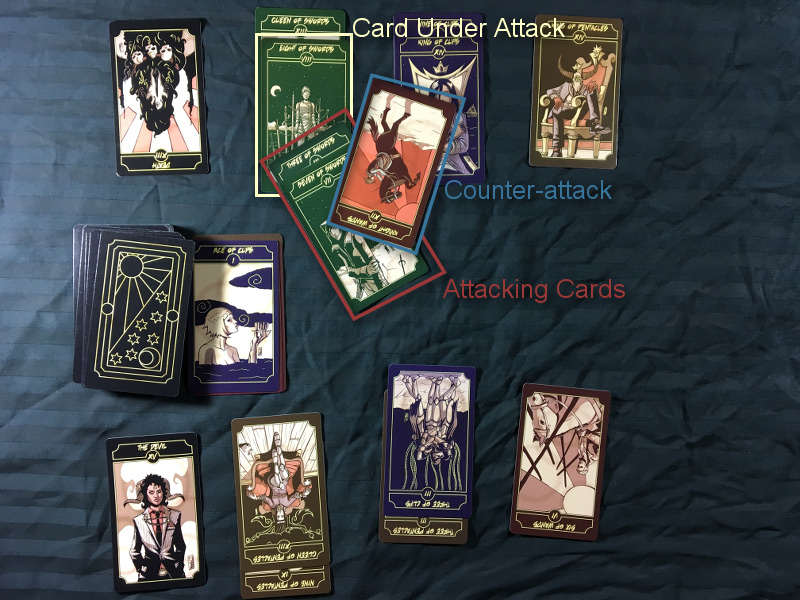
The Eight of Swords is being defended by the counterattacking Knight of Wands.
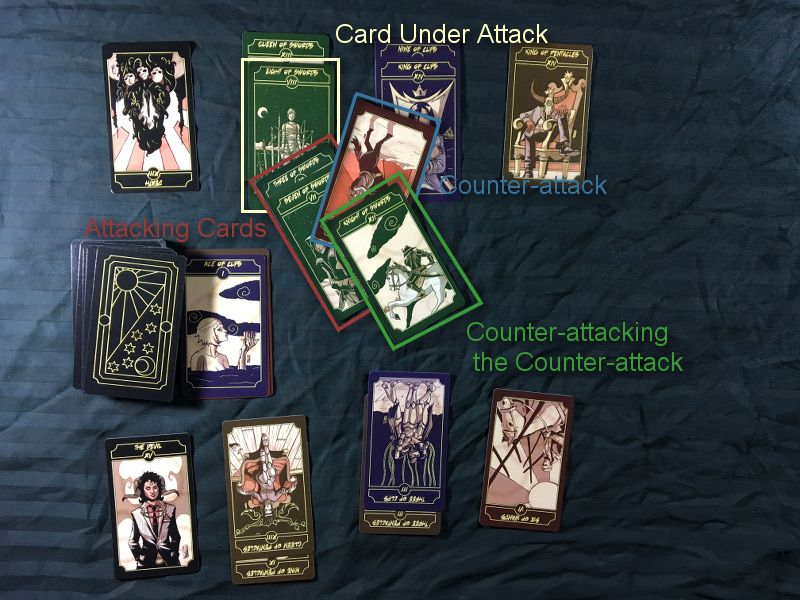
The Knight of Swords counters the Knight of Wands. At this point, the defending player cannot or will not defend further so the attack proceeds. Cards resolve top down, one by one to the discard pile.
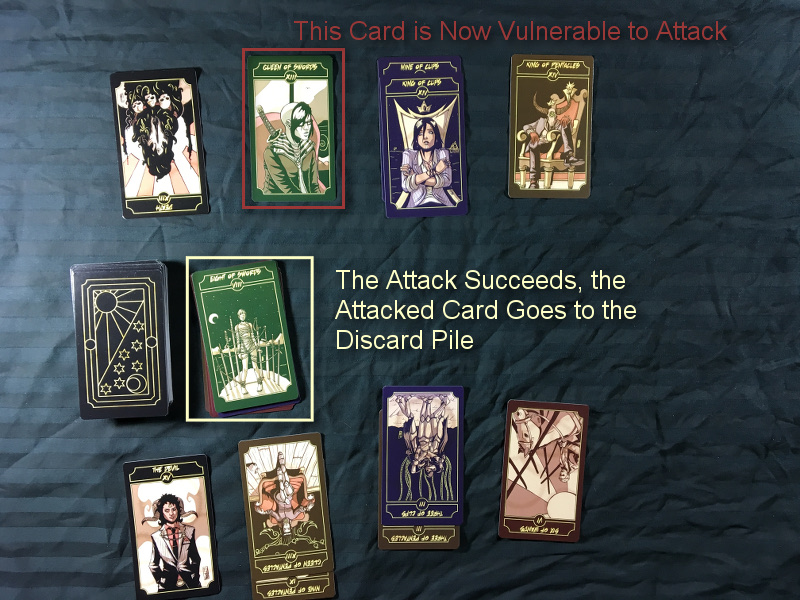
The attack was successful, the Eight of Swords is in the discard pile and the Queen of Swords is now vulnerable to attack.
Special Rules:
This is how the game unfolds, with battles and building, but there are a couple more special rules to get nailed down. Royal cards(page, knight, queen, and kings) are evaluated as numerical values (11, 12, 13, and 14, respectively). They are powerful cards, but they have a weakness!
An ace card can have two different uses. One of them is the standard low value usage of the card. It acts as a single point value card when played against any card that is not royalty, or when used in a stack, which isn’t very exciting. Its second and much more useful ability is in its dominance over royal cards. You may play an ace against a royal card to instantly end the battle and resolve it with the ace card winning. There is no counter-attacking an ace card used against royalty in this manner. However, if used as a counter against stacked attacking cards, the ace only acts as an assassin if both stacked cards are royalty, in which case both are assassinated. If one of the stacked attacking cards is not royalty, the royal card is "guarded" and the ace is only considered a standard single point value card.
The Major Arcana may force players to use a “spoils of war” pile. This card pile acts as a stasis for the turn. The spoils of war pile is private to each player, and when the current player’s turn ends, the cards in players’ spoils of war piles go straight to their hands.
Alternate Game Modes:
House rules are encouraged and different win conditions can be decided upon by the group. Don’t be constrained by the standard rules, feel free to come up with your own version.
Order of operations:
At the beginning of your turn, if you have a Major Arcana that activates before your draw phase, or one that is played at any time, you may use it. Otherwise proceed straight to your draw phase and draw two cards per turn (up to a maximum of five cards unless a Major Arcana's rules say differently) to your hand. After the draw phase, you have a choice. You may choose to play your hand, or go through a discard phase. In a discard phase, you put up to three cards into the discard pile and your turn then ends. You are down that number of cards until your next turn. This is normally only done when you have drawn a rather unfortunate hand.
If you decide to play your hand, you may then build and battle in any order, and even go back and forth between the two phases, as long as you have cards to play. Some players might play defensively and only build, hanging on to their cards in favor of fighting potential attacks. Others might be more offensive and try to use up all of their cards, but a player with no cards in hand makes an easy target. Other players can ask to see how many cards you have in hand at any time, and you are obliged to show them.
There is no way to be out of the game forever. Players cannot die. There is no losing condition, only a winning one, so never count a player out of the game.
Once a player cannot or will not build/battle any more, their turn is over and the next player’s turn begins.
Major Arcana:
Major arcana cards slightly modify the rules of the game according to their historical significance in the tarot. Unless otherwise specified, inverting a Major Arcana is instant and interrupts anything previously unfolding, including abilities of other Major Arcana. The last Major Arcana to be inverted will need to be resolved before the game continues. Once your Major Arcana is used, it is exhausted until you spend a turn to restore it. If you restore your Major Arcana, you may not build or battle for the turn, but you may still draw two cards to your hand.
The abilities of each of the Major Arcana are as follows:
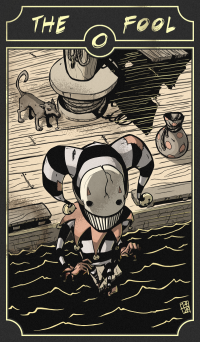 0 - The Fool: Invert the Fool card. For one stack, you are allowed to violate stacking rules and stack any two minor arcana.
0 - The Fool: Invert the Fool card. For one stack, you are allowed to violate stacking rules and stack any two minor arcana.
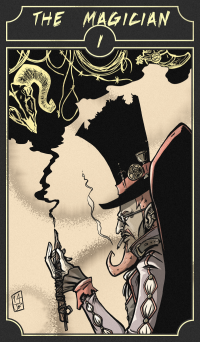 I - The Magician: Invert the Magician card while you have fewer than four cards in your hand. Upon activation, you may draw two cards from the draw pile to your hand, then discard a card from your hand.
I - The Magician: Invert the Magician card while you have fewer than four cards in your hand. Upon activation, you may draw two cards from the draw pile to your hand, then discard a card from your hand.
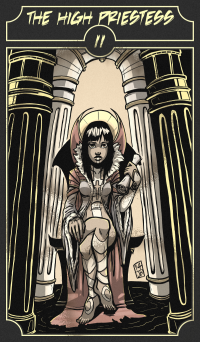 II - The High Priestess: Invert the High Priestess while you have fewer than four cards in your hand in order to draw the top card from the discard pile to your hand.
II - The High Priestess: Invert the High Priestess while you have fewer than four cards in your hand in order to draw the top card from the discard pile to your hand.
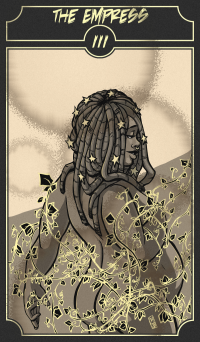 III - The Empress: Invert the Empress card. You may look at the top five cards from the draw pile and then place them back in any order.
III - The Empress: Invert the Empress card. You may look at the top five cards from the draw pile and then place them back in any order.
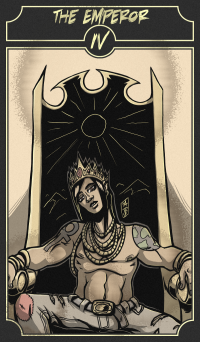 IV - The Emperor: Invert the Emperor card. You may swap cards between your play area and your hand one at a time until your turn is over, as long as you do not violate any stacking rules.
IV - The Emperor: Invert the Emperor card. You may swap cards between your play area and your hand one at a time until your turn is over, as long as you do not violate any stacking rules.
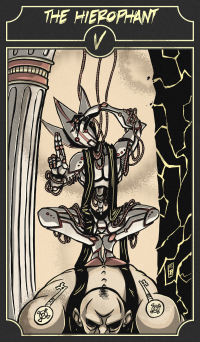 V - The Hierophant: Invert the Hierophant card during your turn. You select your highest value card from your hand and must swap this card with the highest value card from your chosen opponent’s hand. If you are engaged in battle, any cards you swap are sent to you and your opponent’s spoils of war piles. For the purposes of this card, the king is considered the highest value and ace the lowest.
V - The Hierophant: Invert the Hierophant card during your turn. You select your highest value card from your hand and must swap this card with the highest value card from your chosen opponent’s hand. If you are engaged in battle, any cards you swap are sent to you and your opponent’s spoils of war piles. For the purposes of this card, the king is considered the highest value and ace the lowest.
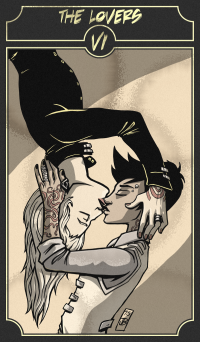 VI - The Lovers: The Lovers card provides a constant passive boost to any of the player’s card stacks that have the same point value, which can now only be attacked or counter-attacked by other paired-value card stacks.
VI - The Lovers: The Lovers card provides a constant passive boost to any of the player’s card stacks that have the same point value, which can now only be attacked or counter-attacked by other paired-value card stacks.
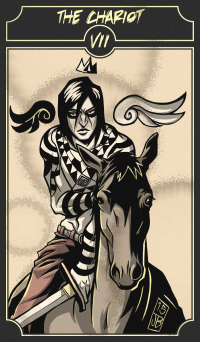 VII - The Chariot: The player with the Chariot card receives a passive boost to their draw phase. They may draw three cards per turn rather than the standard two, but their draw limit is now reduced to three cards, and they start the game with three cards.
VII - The Chariot: The player with the Chariot card receives a passive boost to their draw phase. They may draw three cards per turn rather than the standard two, but their draw limit is now reduced to three cards, and they start the game with three cards.
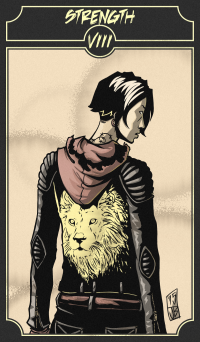 VIII - Strength: Invert the Strength card when a card of yours leaves play. The card is instead sent to your spoils of war pile. You may not use this ability on a card you are discarding from play.
VIII - Strength: Invert the Strength card when a card of yours leaves play. The card is instead sent to your spoils of war pile. You may not use this ability on a card you are discarding from play.
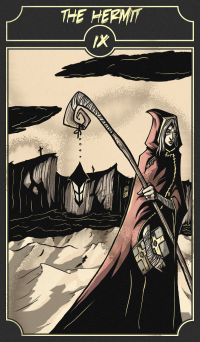 IX - The Hermit: Invert the Hermit card after your draw phase but before your play/discard phase. You then discard your hand for the turn, and your turn ends. On your next draw phase, you draw up to six cards to your hand.
IX - The Hermit: Invert the Hermit card after your draw phase but before your play/discard phase. You then discard your hand for the turn, and your turn ends. On your next draw phase, you draw up to six cards to your hand.
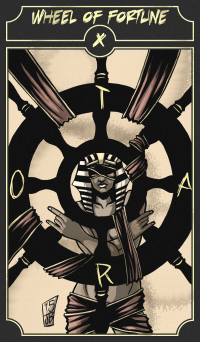 X - Wheel of Fortune: Invert the Wheel of Fortune card after your draw phase. The effect of the wheel of fortune depends on the suit of the next card drawn, which you reveal to the table and then discard. For swords, discard an opponent’s card from play. For wands, choose a card randomly from the hand of an opponent and draw it to your hand. For cups, draw a card to your hand from the draw pile. For pentacles, draw a card from the top of the discard pile and then discard a card from your hand.
X - Wheel of Fortune: Invert the Wheel of Fortune card after your draw phase. The effect of the wheel of fortune depends on the suit of the next card drawn, which you reveal to the table and then discard. For swords, discard an opponent’s card from play. For wands, choose a card randomly from the hand of an opponent and draw it to your hand. For cups, draw a card to your hand from the draw pile. For pentacles, draw a card from the top of the discard pile and then discard a card from your hand.
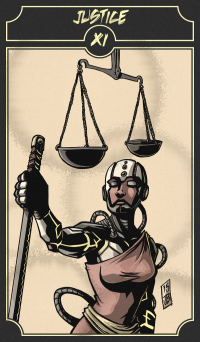 XI - Justice: Invert the Justice card when another player initiates a battle against you. Both players engaged in battle discard down to, or draw up to, three cards in their hand.
XI - Justice: Invert the Justice card when another player initiates a battle against you. Both players engaged in battle discard down to, or draw up to, three cards in their hand.
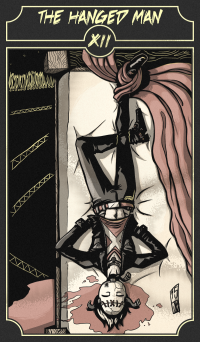 XII - The Hanged Man: Invert the Hanged Man card. You may return any one of your cards in play back to your hand, but you must sacrifice another card from play in its stead. You may also use the Hanged Man on a card currently in battle, provided that you sacrifice a card from play, in which case the card in battle then goes into your “spoils of war” pile, and any cards attacking it go to the discard pile.
XII - The Hanged Man: Invert the Hanged Man card. You may return any one of your cards in play back to your hand, but you must sacrifice another card from play in its stead. You may also use the Hanged Man on a card currently in battle, provided that you sacrifice a card from play, in which case the card in battle then goes into your “spoils of war” pile, and any cards attacking it go to the discard pile.
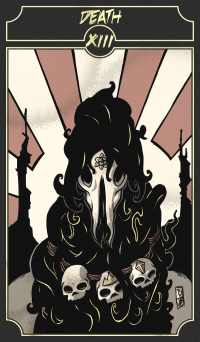 XIII - Death: Invert the Death card. You instantly send a card currently engaged in battle to the discard pile, and the owner of that card draws a new card from the draw pile directly to their hand(but does so only if their card makes it into the discard pile, so be mindful when interrupting the Death card). When used, the battle immediately resolves similar to the usage of an ace. Death may be used against aces.
XIII - Death: Invert the Death card. You instantly send a card currently engaged in battle to the discard pile, and the owner of that card draws a new card from the draw pile directly to their hand(but does so only if their card makes it into the discard pile, so be mindful when interrupting the Death card). When used, the battle immediately resolves similar to the usage of an ace. Death may be used against aces.
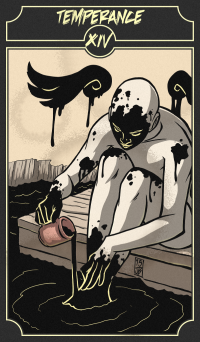 XIV - Temperance: Invert the Temperance card while you have fewer than four cards in your hand. You may discard up to two of your cards in play(but not from your hand or from battle) in order to draw the same number of cards from the top of the discard pile into your spoils of war pile.
XIV - Temperance: Invert the Temperance card while you have fewer than four cards in your hand. You may discard up to two of your cards in play(but not from your hand or from battle) in order to draw the same number of cards from the top of the discard pile into your spoils of war pile.
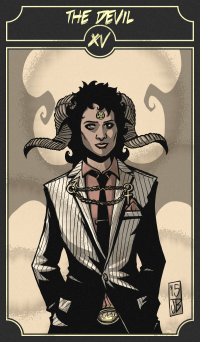 XV - The Devil: The Devil may be used as a 15-point card for attacking or defending. When he is defeated in battle, he is removed from the game. The Devil in battle cannot be targeted by aces, pentacles, or the Death Major Arcana. If the Devil is successful, he returns, inverted, to the owner’s Major Arcana spot.
XV - The Devil: The Devil may be used as a 15-point card for attacking or defending. When he is defeated in battle, he is removed from the game. The Devil in battle cannot be targeted by aces, pentacles, or the Death Major Arcana. If the Devil is successful, he returns, inverted, to the owner’s Major Arcana spot.
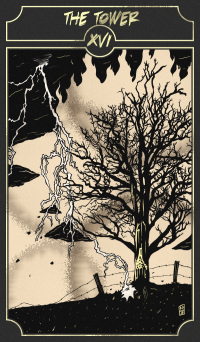 XVI - The Tower: Invert the Tower card. All players with any cards in play must discard one card from play to the discard pile.
XVI - The Tower: Invert the Tower card. All players with any cards in play must discard one card from play to the discard pile.
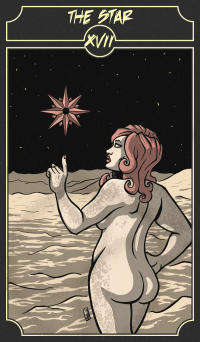 XVII - The Star: Invert the Star card when a battle is initiated. Every player below the draw limit may draw up to two cards(or up to their draw limit, whichever occurs first) from the draw pile.
XVII - The Star: Invert the Star card when a battle is initiated. Every player below the draw limit may draw up to two cards(or up to their draw limit, whichever occurs first) from the draw pile.
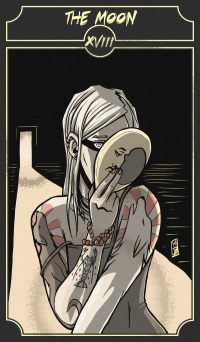 XVIII - The Moon: Invert the Moon card. All players must place four cards into their spoils of war piles from their hand.
XVIII - The Moon: Invert the Moon card. All players must place four cards into their spoils of war piles from their hand.
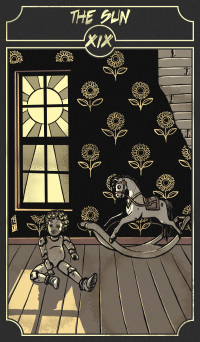 XVIX - The Sun: The Sun card provides a constant passive effect. The player with the Sun card starts the game with seven cards and has a draw limit of seven cards.
XVIX - The Sun: The Sun card provides a constant passive effect. The player with the Sun card starts the game with seven cards and has a draw limit of seven cards.
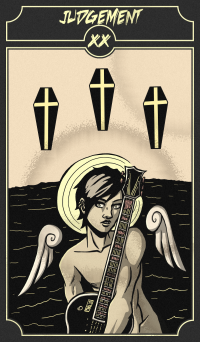 XX - Judgement: Invert the Judgement card when someone attacks you. The attack fails and their attacking card(s) are sent to the discard pile.
XX - Judgement: Invert the Judgement card when someone attacks you. The attack fails and their attacking card(s) are sent to the discard pile.
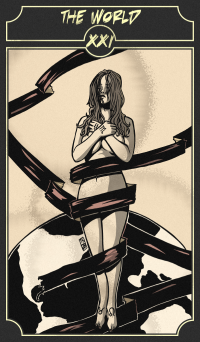 XXI - The World: Invert the World card. All players must discard their hands to the bottom of the draw pile. Players may then draw the same number of cards that they discarded from the top of the draw pile to their hands.
XXI - The World: Invert the World card. All players must discard their hands to the bottom of the draw pile. Players may then draw the same number of cards that they discarded from the top of the draw pile to their hands.